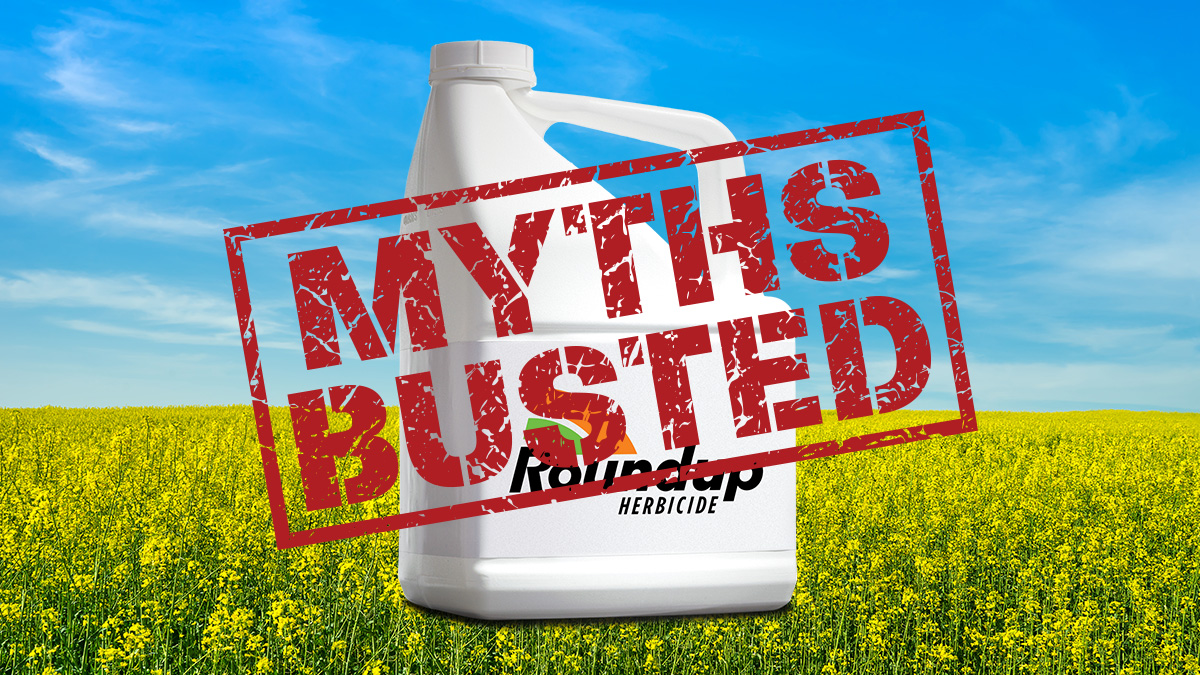Roundup Application Myths Busted
Feb 12, 2020
Farming is full of a lot of old sayings and weird lore about what works and what doesn't – including myths around herbicide use. So if you want to get the best performance and the most bang for your herbicide buck, take a moment to refresh your Roundup knowledge.

MYTH: You should wait until all weeds have emerged before spraying Roundup.
FACT: Not true! Many studies have shown that early weed removal in canola protects and preserves yield, and is more economical, too.1
Indeed, in one study from Agriculture and Agri-Food Canada estimates that a single weed emerging a week before the crop has the same effect on yield outcome as 100 weeds emerging three weeks after the crop.2 Studies from various public institutions show that controlling weeds when canola is at the 1- to 2-leaf stage provides the best yield advantage3.
Waiting for more weeds to emerge is tempting, but consider the fact that weeds get bigger as you wait and become harder to control once you do spray.
A good pre-seed burndown with a tank mix partner is not only a good resistance management strategy, it can also set you up for even greater success with early weed removal once the crop has emerged. The bottom line is that removing weeds early may even mean you don’t need to spray again, but the option is always there if conditions change.
MTYH: TruFlex™ canola with Roundup Ready® technology means using more Roundup.
FACT: Not true. The TruFlex canola trait is a crop safety enhancement over the previous Roundup Ready® Technology. TruFlex canola hybrids have an increased tolerance to glyphosate, and that means you have a wider application window (from cotelydon to first flower) than with any other Roundup Ready canola hybrids – 10 to 14 more spray days, in fact.
In terms of early weed control, it means you have a bit more flexibility with spray timing which is helpful if weather delays your herbicide application. To be more specific, only TruFlex canola gives you options on herbicide rates and timing.
- Spray twice: TruFlex canola allows for two applications of Roundup WeatherMAX® at the 0.67 L/ac. rate, right up to first flower. So if weather or a late flush of weeds delays your spray date, it’s not a problem. You can make the first application when you’re able, then assess the field later in the season to see if a second pass is warranted. If it is, try spraying in the opposite direction to ensure optimal coverage.
- Spray once: The TruFlex canola system also gives you the option to go in with one application of Roundup WeatherMAX at 1.33 L/ac., up to the 6-leaf stage. So if you’ve got bigger weeds, or some of the tougher to control ones, you have this option to take care of them and protect your yield.
MYTH: You can use Roundup no matter what the conditions.
FACT: Not quite true! Growers have come to appreciate the powerful weed control that Roundup provides in its canola systems – even in sub-optimal conditions where other herbicide systems may struggle.
But the key to this performance, as with any herbicide, is to use the product as directed! Ideally, Roundup should be sprayed when temperatures are no less than 4°C and no greater than 30°C. In both instances, control may be delayed or diminished because it is either too hot or too cold for weeds to effectively take up and translocate the glyphosate
Similarly, weeds that are stressed by weather, disease or insect damage have a reduced capacity to move Roundup, which may result in less than ideal control. The key thing to remember is that weeds must be more than 60% green and actively growing for good results.
Having said that, Roundup WeatherMAX comes with a 30-minute rainfast guarantee and is backed by an industry leading all weather warranty4. So if you’re experiencing tough environmental conditions and worried about the weeds getting too far ahead, this is the Roundup formulation to choose.
MYTH: Roundup doesn't work fast.
FACT: Not true! Roundup takes mere minutes to penetrate leaf surfaces and start to get to work. What is true is that it can take a week to 10 days for visible symptoms of control to appear.
That’s because glyphosate is a systemic herbicide – it takes a bit of time for the plant to push the active ingredient down into its roots. So even though you might not see that satisfying burn within a day or two after application, be assured that weed is a goner.
MYTH: Roundup means resistance problems.
FACT: Again, not true! Roundup has an important role to play in a strong resistance management program.
Herbicides stop working when weed species find a way around the active ingredient, either by developing an ability to metabolize it, or changing its biological target site (usually an enzyme) to block it. More simply put, weeds adapt.
That means you need to keep them guessing by rotating herbicide groups, using tank mixes that consist of multiple, effective modes of action and using full, recommended herbicide rates. Also diversifying your crop rotation and using cultural practices (where possible) can help to manage resistance as well.
Like all herbicides, Roundup must be used with care to delay resistance developing in the weeds it still effectively controls. To date, kochia and waterhemp are the only weeds in Western Canada to develop glyphosate resistance. It means Roundup is still an effective tool when it comes to “spicing up your mix” when it comes to overall weed control in the field, and can help control the many resistant weeds throughout western Canada.
Visit MixItUp.ca to find out more about herbicide resistance and what you can do to protect your farm and your herbicide tools.
Footnotes
1,2,3 Spray Early: Economics of Early Weed Control: https://www.canolawatch.org/2018/06/06/spray-early-economics-of-early-weed-control/
4 Roundup WeatherMAX info page: https://www.roundup.ca/en/roundup-weather-max